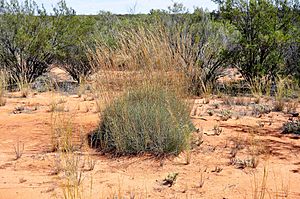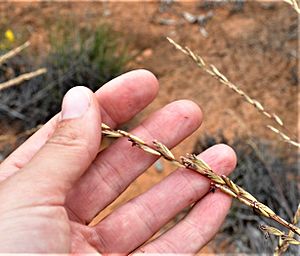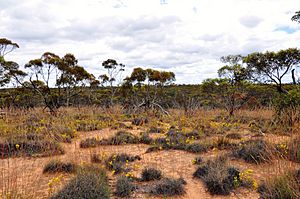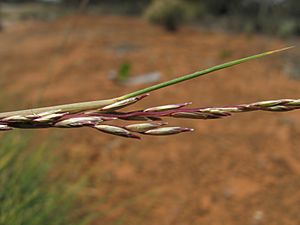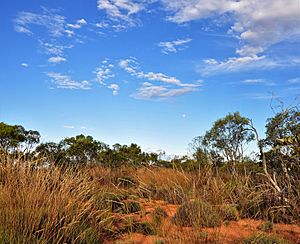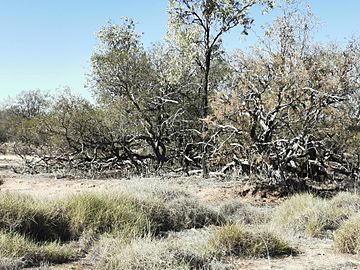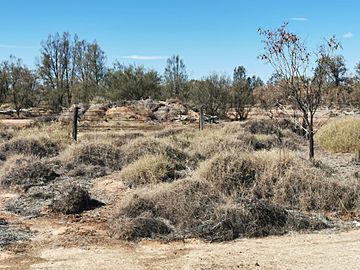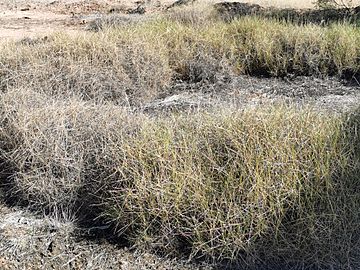Porcupine grass facts for kids
Quick facts for kids Porcupine grass |
|
|---|---|
 |
|
| Triodia scariosa showing its ring shape with flowers | |
| Scientific classification | |
| Genus: |
Triodia (plant)
|
| Species: |
scariosa
|
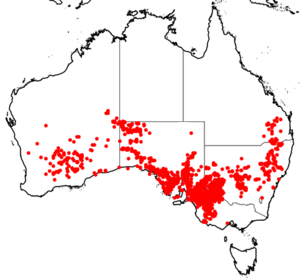 |
|
| Where Triodia scariosa grows in Australia | |
Triodia scariosa, often called porcupine grass or spinifex, is a special type of grass. It is found only in Australia. This plant is part of the Triodia family of grasses.
It is a perennial plant, meaning it lives for many years. It stays green all year round. These grasses grow in round mounds called hummocks. These mounds can be up to about 1 meter (3 feet) tall.
The leaves are long and thin, like needles. They are about 30 centimeters (12 inches) long and very stiff. The plant also grows a tall flowering stalk. This stalk can reach up to 2 meters (6.5 feet) high. The flowers grow in a loose cluster called a panicle.
The name Triodia comes from Latin. It means "three-toothed" because of the shape of its flower parts. Scariosa refers to its thin, dry flower coverings. This grass is common in dry and semi-dry parts of Australia. You can find it in Mallee woodlands and hummock grasslands.
Contents
The Grass Family Tree
Triodia scariosa belongs to a very old group of plants. This group is called Poales. It includes grasses, sedges, and their relatives. Plants in the Poales group are found all over the world. They make up about one-third of all monocot plants. They are also about 7% of all flowering plants.
The Poales group started to grow differently from other monocots a long time ago. This was over 65 million years ago. Scientists can tell them apart by looking at their genes.
Within the Poales group, Poaceae is the largest family. This is the grass family. Grasses are known for how their shoots grow in a branching pattern. The grass family is linked to places like South America and Africa. Australia broke away from a supercontinent called Gondwana about 35 million years ago. This event helped new types of grasses grow in Australia.
The Triodia group is part of the Chloridoideae subfamily. These plants likely grew in drier places. They developed a special way to make food called C4 photosynthesis. This helps them grow better in hot, dry areas.
A botanist named Robert Brown first described the Triodia group in 1810. At that time, it included six different types of grass. Since 1937, it has only included Australian species. Today, there are 73 known types of Triodia, and more are still being found. T. scariosa is one of them. Thanks to DNA testing, scientists can now identify species more accurately. For example, a study in 2012 found that T. scariosa and T. bunicola were actually the same plant. Now they are known as one species.
Where It Grows
Triodia scariosa grows in dry and semi-dry parts of mainland Australia. It is found south of about 24 degrees latitude. This means it is not found in the Northern Territory or Tasmania. It usually grows in areas that get between 200-400mm of rain each year.
This grass is most common in the Mallee ecosystem. This area has a Mediterranean-type climate. You can find lots of it in Western Australia, South Australia, and western Victoria. While it does grow in the very dry hummock grasslands, it is not as dense there.
T. scariosa grows much better in the semi-dry Mallee ecosystem. This is because it gets more rain there. Also, the Mallee has yellow sandy soils. The dry interior has red sandy soils.
Its Importance and Protection
Triodia scariosa is a common plant. It is not currently listed as endangered or threatened. However, many other threatened animals and ecosystems rely on this grass. It is a very important plant for them.
For example, in a special grassland area in New South Wales, T. scariosa provides habitat for three endangered lizard species. These lizards are Cyclodomorphus melanops elongatus, Delma australis, and Ctenophorus decresii.
In the Murray-Mallee region, the grass faces some challenges. Past land clearing, breaking up of habitats, and changes in fire patterns affect it. Climate change also plays a role. These things might impact how well T. scariosa survives in the long run. Many unique and threatened animals depend on this grass to live in the wild. Examples include the Mallee Emu-wren (Stipiturus Mallee), the Ningaui yvonneae, and the Mallee military dragon (Ctenophorus fordi).
How It Lives and Helps the Environment
T. scariosa is a foundation species. This means it is very important for the health of its ecosystem. It helps make the environment strong and stable. Many different animals use T. scariosa. These include birds, mammals, reptiles, and insects. They use the grass for finding food, building nests, hiding from predators, and staying cool.
The endangered Mallee Emu-wren relies completely on Stipiturus mallee. This bird lives only in the Murray-Mallee area. It uses the grass for hunting, nesting, mating, and finding food. It rarely leaves the grass hummocks. Also, many different types of lizards live in and around T. scariosa.
The types of plants that grow with T. scariosa depend on where it is found. They also depend on the climate of the region. In very dry areas, it grows with other Triodia species. It also grows with Acacia, Corymbia, and Eucalyptus trees. In the southern parts of its range, it often grows under Mallee Eucalypts. These include Eucalyptus dumosa and E. socialis. It can also be found with Callitris, Melaleuca, Acacia, and Hakea plants.
T. scariosa likes soils that do not hold much water or nutrients. Its roots grow deep and wide. This helps to hold the soil in place. It stops the thin topsoil layer from being blown away by wind.
This grass also plays a big part in how fires happen in the landscape. As the plants get older, they collect dry material. This dry material can fuel fires. In the Murray-Mallee, wildfires can be very large. They can burn thousands of hectares. The continuous grass helps the fire spread. This can kill the trees above the grass. After a fire, all the plants are removed. Then, new plants grow back in a clear way. This includes the animals too.
The time between wildfires affects how T. scariosa grows back. It also affects how much dead material builds up. This material helps fires start and spread. This usually happens at least 10–20 years after a fire. It peaks around 20–30 years. But if there has been a lot of rain, it can happen in just 2 years.
Life Cycle and Growth
The growth of T. scariosa is strongly linked to rainfall and fire. Heavy rain, especially in late spring or early summer, causes many seeds to grow. This also helps new seeds get into the soil. Fire kills the adult plants. But it also makes the stored seeds in the soil sprout. If rain follows the fire, even more seedlings will grow.
If there are no fires for a long time, the seeds cannot grow as well. This is because the seeds only stay good for 2–3 years. The plant can also grow back a little from its base. This helps it survive in dry areas where there is less rain. Scientists are still learning about how Triodia plants reproduce. They think the plants can fertilize themselves or be fertilized by other plants.
T. scariosa grows outwards using special stems called stolons. As the plant gets older, it spreads out from its center. The size and shape of each plant depend on how long it has been since a fire. They also depend on the soil, other plants and animals around it, and the climate.
Because it uses C4 photosynthesis, T. scariosa grows faster in warmer temperatures. It also uses water very well. Its growth is even better with summer rain. In the first few years after a fire, T. scariosa grows quickly. It reaches its fullest size around 30 years. Then, it slowly declines over the next few decades. It is thought that T. scariosa needs more than 20 years between fires. This allows the plants to grow, make seeds, and create good habitats. This helps make sure the grass can grow back well after a fire.
A special thing about T. scariosa is its ring shape as it ages. As the plant gets older, it grows outwards in a ring or crescent shape. The old parts in the center die off. These rings can grow up to 3 meters (10 feet) wide. Sometimes, many plants join together to form patterns like reefs in the landscape. These rings are rare in the first 20–30 years after a fire. But they are most common around 55 years. After that, the plant slowly dies off.
Gallery
- Spinifex country, Yelarbon, Queensland


